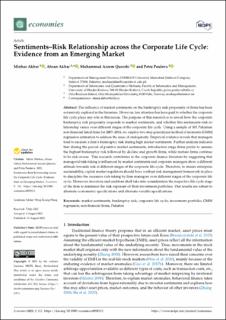| dc.contributor.author | Minhas, Akbar | |
| dc.contributor.author | Ahsan, Akbar | |
| dc.contributor.author | Qureshi, Muhammad Azeem | |
| dc.contributor.author | Poulova, Petra | |
| dc.coverage.spatial | Pakistan | en_US |
| dc.date.accessioned | 2021-10-01T08:44:44Z | |
| dc.date.available | 2021-10-01T08:44:44Z | |
| dc.date.created | 2021-08-16T14:01:44Z | |
| dc.date.issued | 2021-08-11 | |
| dc.identifier.issn | 2227-7099 | |
| dc.identifier.uri | https://hdl.handle.net/11250/2786902 | |
| dc.description.abstract | The influence of market sentiments on the bankruptcy risk propensity of firms has been extensively explored in the literature. However, less attention has been paid to whether the corporate life cycle plays any role in this nexus. The purpose of this research is to unveil how the corporate bankruptcy risk propensity responds to market sentiments, and whether this sentiments–risk relationship varies over different stages of the corporate life cycle. Using a sample of 301 Pakistani non-financial listed firms for 2005–2014, we employ two-step generalized method of moments (GMM) regression estimation to address the issue of endogeneity. Empirical evidence reveals that managers tend to escalate a firm’s bankruptcy risk during high market sentiments. Further analysis indicates that during the period of positive market sentiments, introduction stage firms prefer to assume the highest bankruptcy risk followed by decline and growth firms, while mature firms continue to be risk-averse. This research contributes to the corporate finance literature by suggesting that managerial risk-taking is influenced by market sentiments and corporate managers show a different attitude towards risk at different stages of the corporate life cycle. Therefore, to ensure enterprise sustainability, capital market regulators should have a robust risk management framework in place to discipline the excessive risk-taking by firm managers over different stages of the corporate life cycle. Moreover, investors and creditors shall take into consideration the respective life cycle stage of the firm to minimize the risk exposure of their investment portfolios. Our results are robust to alternate econometric specifications and alternate variable specifications. | en_US |
| dc.description.sponsorship | The open access of this research is supported by the SPEV project 2021 at the Faculty of Informatics and Management, University of Hradec Kralove, Czech Republic. | en_US |
| dc.language.iso | eng | en_US |
| dc.publisher | MDPI | en_US |
| dc.relation.ispartofseries | Economies;Volume 9, Issue 3 | |
| dc.rights | Navngivelse 4.0 Internasjonal | * |
| dc.rights.uri | http://creativecommons.org/licenses/by/4.0/deed.no | * |
| dc.subject | Market sentiments | en_US |
| dc.subject | Bankruptcy risks | en_US |
| dc.subject | Corporate life cycles | en_US |
| dc.subject | Investment portfolios | en_US |
| dc.subject | GMM regressions | en_US |
| dc.subject | Non-financial firms | en_US |
| dc.subject | Pakistan | en_US |
| dc.title | Sentiments–Risk Relationship across the Corporate Life Cycle: Evidence from an Emerging Market | en_US |
| dc.type | Peer reviewed | en_US |
| dc.type | Journal article | en_US |
| dc.description.version | publishedVersion | en_US |
| dc.rights.holder | © 2021 by the authors. | en_US |
| dc.source.articlenumber | 111 | en_US |
| cristin.ispublished | true | |
| cristin.fulltext | original | |
| cristin.qualitycode | 1 | |
| dc.identifier.doi | https://doi.org/10.3390/economies9030111 | |
| dc.identifier.cristin | 1926331 | |
| dc.source.journal | Economies | en_US |
| dc.source.volume | 9 | en_US |
| dc.source.issue | 3 | en_US |
| dc.source.pagenumber | 1-17 | en_US |

